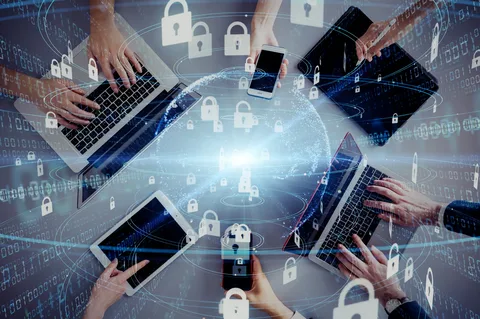
INTRODUCTION:
In today’s fast-paced digital world, the intersection of technology and mental health has become increasingly evident. Tech and mental health are two aspects of our lives that are increasingly interconnected. It’s important to understand the difference between behavioral and mental health tech, as they play distinct roles in supporting our well-being in this digital age. Behavioral health tech focuses on tools and applications designed to address specific behaviors or conditions, such as addiction or eating disorders, and often involves therapeutic interventions. On the other hand, mental health tech encompasses a broader range of digital solutions aimed at enhancing overall mental well-being, including meditation apps, mood tracking, and online support communities.
The Impact of Digital Devices on Mental Well-being:

In today’s tech-driven world, the impact of digital devices on mental health cannot be overlooked. The constant presence of smartphones, tablets, and laptops has led to a significant shift in how individuals interact with technology and, subsequently, how it affects their well-being. Numerous studies have highlighted the potential negative effects of excessive tech usage on mental health, including increased levels of stress, anxiety, and depression. It is crucial to recognize that while technology brings undeniable convenience and connectivity, its overuse or misuse can have detrimental consequences.
The link between tech and mental health is a complex one. On one hand, digital devices and platforms have enabled access to valuable resources and support networks, enhancing mental well-being in various ways. Online therapy services and mental health apps, for example, have made therapy more accessible to individuals who might otherwise struggle to access it. On the other hand, research suggests that prolonged screen time and excessive use of social media can contribute to feelings of loneliness, comparison, and even addiction. It is essential to strike a balance between taking advantage of the benefits technology provides and being mindful of its potential drawbacks to safeguard our mental health.
Identifying the Indicators of Excessive Screen Time:

Excessive screen time has become a prevalent issue in today’s digital age. As individuals increasingly rely on digital devices for work, entertainment, and socialization, it is important to be aware of the signs that indicate screen time overload. Balancing screen time and offline time is crucial for maintaining mental well-being, and recognizing the signs of excess can be the first step towards finding a healthier equilibrium.
One common sign of screen time overload is the feeling of being constantly glued to a device. If you find yourself unable to go for even a short period without checking your phone, scrolling through social media, or engaging in online activities, it may be an indication that you have become dependent on your digital device. This can lead to a lack of presence in the real world and a difficulty in disconnecting from the virtual one. Additionally, if you notice a decrease in productivity or an inability to focus on tasks due to excessive screen time, it might be time to reassess your digital habits.
Establishing Healthy Boundaries with Technology:

Setting boundaries with technology is crucial for maintaining a healthy relationship with digital devices. It is essential to establish clear guidelines on when and where technology should be used. This means creating designated spaces and times where digital devices are not allowed, such as during meals or before bedtime. By setting these boundaries, individuals can ensure that technology does not interfere with important aspects of life, such as family time or relaxation.
Another important aspect of establishing healthy boundaries is learning to prioritize human connection over screen time. This means setting aside designated time for face-to-face interactions with loved ones and friends, without the constant interruption of digital devices. It is also important to be mindful of the impact of technology on social interactions, and to use it in a way that enhances rather than replaces real-life connections. By prioritizing human connection, individuals can foster meaningful relationships and improve their overall mental well-being.
Finding the Right Balance: Setting Screen Time Limits

In our digitally-driven world, finding the right balance of screen time is crucial for maintaining our mental well-being. With the constant barrage of notifications and the temptation to constantly engage with our devices, it can be easy to lose track of time and become consumed by the virtual world. However, setting screen time limits can help us regain control over our tech usage and prioritize our mental health.
One effective approach to setting screen time limits is to establish specific boundaries and rules for ourselves. This can involve creating designated periods of time where we refrain from using our devices, such as during meals or before bedtime. By implementing these boundaries, we can create a healthier relationship with technology and ensure that it does not interfere with our daily routines or our interpersonal relationships.
Additionally, using tools like screen time trackers or apps that limit usage can also be helpful in holding ourselves accountable and staying within our designated limits. By consciously managing our screen time, we can strike a balance between staying connected and present in the real world, while still enjoying the benefits of digital technology.
Mindful Tech Usage: Incorporating Digital Detoxes

With the ever-increasing reliance on digital devices in our daily lives, it has become crucial to take regular breaks from technology to maintain our mental well-being. Incorporating digital detoxes into our routines can provide much-needed respite from the constant stimulation of screens and allow us to reconnect with ourselves and the world around us.
During a digital detox, it is important to set boundaries for ourselves and establish designated tech-free times or spaces. This can involve powering down our devices during meals, dedicating specific hours of the day to engage in non-digital activities, or even designating entire weekends as screen-free zones. By doing so, we create opportunities to engage in other areas of our lives that may have been neglected due to excessive screen time. We can use this time to read a book, engage in outdoor activities, spend quality time with loved ones, or simply take a moment to reflect and recharge. Overall, incorporating digital detoxes into our lives fosters mindfulness and allows us to strike a healthier balance between the digital world and our mental well-being.
The Role of Social Media in tech and Mental Health:

Social media has become an integral part of modern society, with billions of people engaging in online platforms daily. While it offers numerous benefits, such as connecting people across the globe and providing a platform for self-expression, its impact on mental health cannot be overlooked. Research has shown that excessive social media use is associated with various mental health issues, including feelings of loneliness, depression, and low self-esteem. Constant exposure to carefully curated highlight reels of others’ lives can lead to detrimental comparisons and unrealistic expectations, contributing to a decline in overall well-being.
Moreover, the addictive nature of social media platforms poses a significant challenge to mental health. The instant gratification provided by likes, comments, and shares can create a never-ending cycle of seeking validation and approval. This constant craving for social validation can negatively impact individuals’ self-esteem and self-worth, leading to feelings of inadequacy and heightened anxiety.
Additionally, the constant stream of information and news on social media can be overwhelming, exposing individuals to distressing or triggering content, further exacerbating mental health issues. Overall, while social media can provide opportunities for connection and communication, it is crucial to be aware of its potential negative impacts on mental well-being.
Nurturing Mental Health through Digital Wellness Apps:
Digital wellness apps have become increasingly popular in recent years as individuals look for ways to prioritize their mental well-being in a digital world. These apps offer a range of features and tools designed to promote relaxation, mindfulness, and stress reduction. With just a few taps on their smartphones, users can access guided meditations, breathing exercises, and even mood trackers to help them better understand and manage their emotions.
One of the key benefits of digital wellness apps is their accessibility. Whether at home or on the go, individuals can easily incorporate these apps into their daily routines. They can take a few moments during their lunch break to engage in a quick meditation session or use the apps before bed to unwind and promote better sleep. Additionally, some apps also offer community features, allowing users to connect with like-minded individuals and share their experiences and progress on their mental health journey.
Tech Tools for Relaxation and Stress Reduction:
In the fast-paced world we live in, stress and anxiety have become common experiences for many. Thankfully, technology offers various tools to help us relax and reduce stress. One such tool is meditation apps. These apps provide guided meditations that can be easily accessed and practiced anytime, anywhere. With features like customizable meditation lengths and soothing background sounds, they cater to individuals looking to incorporate mindfulness into their daily routine.
Additionally, some apps offer breathing exercises and stress-relief techniques, allowing users to choose the method that works best for them. By utilizing these tech tools, individuals can find moments of tranquility amidst the chaos of their busy lives.
Another popular tech tool for relaxation and stress reduction is sleep and relaxation apps. These apps provide a range of features to help users unwind and improve their sleep quality. Gentle nature sounds, calming music, and bedtime stories are just a few of the options available to create an optimal sleeping environment.
Furthermore, some apps track sleep patterns, providing users with insights into their sleep quality and offering recommendations for improvement. These tech tools can be particularly beneficial for those struggling with insomnia or disrupted sleep patterns. By utilizing these apps, individuals can create a serene atmosphere conducive to relaxation and rejuvenation, leading to a more balanced and rested state of mind.
Prioritizing Human Connection in a Digital World:

In today’s digital world, it is crucial to prioritize human connection amidst the constant influx of technology. While technology has undeniably made communication more accessible, it has also created barriers to genuine human interaction. The prevalence of social media, instant messaging, and virtual meetings has seemingly replaced face-to-face interactions, leading to a decline in meaningful connections.
It is essential to recognize the value and significance of personal connections and make a conscious effort to prioritize them. Engaging in meaningful conversations, spending quality time with loved ones, and nurturing relationships offline are essential for mental well-being. By setting aside dedicated time to connect with others in person, we can foster deeper bonds, strengthen social support networks, and enhance our overall happiness and fulfillment. Regardless of the convenience and ease of digital communication, the power of personal connection should never be underestimated.
Cultivating a Healthy Relationship with Technology:
In today’s digitally connected world, cultivating a healthy relationship with technology is crucial for our overall well-being. It is important to recognize the role that technology plays in our lives and the impact it can have on our mental health. By being aware of our digital habits and making conscious choices, we can foster a more positive and balanced connection with the digital world.
One key aspect of cultivating a healthy relationship with technology is establishing boundaries. It is easy to get caught up in the constant stream of notifications and the temptation to always be connected. However, setting limits on screen time can help prevent overload and ensure that we are giving ourselves time and space for other important aspects of life. By creating designated tech-free zones or specific times for device-free activities, we can regain a sense of control and balance in our relationship with technology.
FINAL THOUGHTS:
Finding a good balance between using technology and taking care of our mental health is now really really important. We should be careful not to spend too much time staring at screens, like phones and computers, because it can affect how we feel. It’s essential to be mindful and make sure that technology doesn’t take over our lives and make us feel stressed or unhappy. By being aware of how much time we spend on screens and using technology in a smart way, we can make sure we stay mentally and physically healthy in this digital world.














